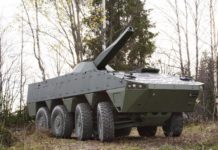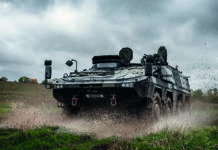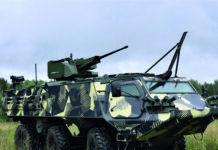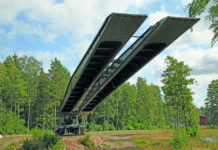In recent years, most armies have introduced heavier tracked and wheeled Armoured Fighting Vehicles (AFV) into service. This has meant that existing bridges have had to be upgraded, or sometimes replaced, to take into account these heavier vehicles.
A previous article in ESD 4/2020 covered armoured combat bridging, but this is just one part of the total bridging capability deployed by combat engineers of the major powers to enable their units to rapidly cross wet and dry gaps. These include lightweight bridging systems that are typically deployed by the infantry, mobile bridges to enable wider gaps to be crossed, amphibious bridging and ferry systems, pontoon bridges and line of communication bridges which are deployed to the rear once the initial advance has been completed. While these bridges have been originally developed and deployed for military use they are also used by an increasing number of countries in emergency disaster relief operations such as the urgent replacement of bridges lost during floods and landslides.
Prior to bridges being deployed, it can be required to lay a trackway on marginal terrain so that the ground is not turned into a total quagmire due to constant use. Faun Trackway of the UK are the market leader with sales having been made to some 40 countries with their Heavy Ground Mobility System (HGMS) and Medium Ground Mobility Systems (MGMS). These are rapidly laid over the rear the vehicle as it moves backwards and with the HGMS having a MLC 70 and MGMS MLC 30. These are also used during amphibious operations on beaches.
Crossing Dry Gaps
One of the major growth areas in combat bridging is the development and fielding of smaller bridges which are typically used by infantry units. A good example of this is the General Dynamics European Land Systems (GDELS) Bridging MAMBA, previously called the Infantry Assault Bridge (IAB) which is known to have been sold to:
- Austria
- Germany
- Ireland
- the Netherlands
- the UK
The complete MAMBA set weighs only 460 kg, with the heaviest element weighing only 55 kg. According to GDELS-Bridging, a bridge 30 m in length can be constructed in about 6 minutes. Although the MAMBA is normally deployed to cross dry gaps, with the aid of lightweight pontoons it can also be used to cross wet gaps with the pontoons being anchored in position.
The company has also developed and is marketing the VIPER (previously called the Medium Trackway Bridge) which is also of aluminium construction and has been designed for use by vehicles up to Military Load Class 40 (MLC 40) and is typically transported on a 4×4/6×6/8×8 or a tracked platform. According to GDELS-Bridging, the launching and retrieving time for a four metre VIPER is less than five minutes with four soldiers. Additional units can be added to the VIPER to extend dry gap crossing capability to six or eight m, with the actual bridge length being seven and nine metres respectively.
The PYTHON REBS
GDELS-Bridging has also developed the PYTHON Rapidly Emplaced Bridge System (REBS) for which the launch customer was the US Army who ordered 20 systems. The US Army transports and launches the PYTHON REBS over the rear of an Oshkosh Heavy Expanded Mobility Tactical Truck (HEMMT) (8×8) Palletised Load System (PLS) chassis fitted with Bridge Adapter Pallet (BAP) and when deployed this two part bridge is 13.80 m long and can be used to bridge a gap of up to 13 m and take vehicles up to MLC 50 with launch time of 10 minutes. The actual bridges are the same as those used in the German Army BEAVER (BIBER) based on the LEOPARD 1 tank hull still used by the German and other armies.
A batch of PYTHON REBS was purchased by the British Army to meet an Urgent Operational Requirement (UOR) and these are transported and launched from a Rheinmetall MAN Military Vehicles HX series (8×8) truck and one of these was loaned to the New Zealand Army. As well as being deployed by a dedicated launch platform it can also be integrated onto a Palletised Load System (PLS) so on the system is deployed the truck can be utilised for other missions.
The Dry Support Bridge
Following a competition, WFEL was awarded a US Army contract for the Heavy Dry Support Bridge (HDSB) was first fielded by the US Army under the designation of the M18 DSB with over 100 systems now supplied. In US Army service, the M18 DSB is transported and launched from an M1077 Oshkosh (10×10) HEMTT/PLS with one set consisting of one launcher vehicle, six M1077 flat track of bridge components and one M1077 flat track load of launch beams. This is sufficient to complete one 42 m long bridge, which would span a gap of 40 m and take only 90 minutes to assemble. This was originally to MLC 80 (tracked) and MLC 100 (wheeled) but development has enabled bridges with a length of 46 m to be constructed.
While the US Army uses the Oshkosh chassis the design of the DSB is that it can be integrated onto other platforms with Australia, for example, using the German Rheinmetall MAN Military Vehicles HX (10×10) platform while Switzerland uses an Iveco Defence Vehicles TRAKKER (10×8) chassis. Other customers include the Philippines (Reinmetall MAN) and Turkey (HEMTT).
Amphibious Bridging and Ferry Systems
One of the most recent wet crossing systems is the Turkish FNSS Savunma Sistemleri OTTER (4×4) Rapid Deployable Amphibious Wet Gap Crossing System (RDAWGCS), which has been developed by the local company of FNSS Savunma Sistemleri to meet the requirements of the Turkish Army who have taken delivery of 32 units and is now being offered on the export market.
When being used in the ferry mode, a single OTTER can transport tracked vehicles with a MLC of up to 21 which can be increased to tracked vehicles with a MLC 85 with two units and wheeled vehicles up to MLC 120 with three units. When 12 OTTER units are coupled together, a bridge 150 m in length can be quickly deployed which can take tracked vehicles up to MLC 85 and wheeled vehicles up to MLC 120. The OTTER crew are seated in a protected cab at the front and it also features all wheel steering, independent air suspension and when afloat is powered by two pump jets at a maximum speed of up to 10 km/h.
The GDELS M3
The market leader for amphibious bridging and ferry systems is the General Dynamics European Land Systems – Bridging (GDELS) M3 Amphibious Bridge and Ferry System (ABFS) which is a further development of the older M2. The first customers for the M3 were Germany and the United Kingdom but since then sales have been made to other countries including:
- Indonesia
- Latvia
- Singapore
- South Korea
- Taiwan
Late in 2021, the Republic of Korea selected the M3 to meet its requirement for a Korean Amphibious Bridging Vehicle (KABV), with GDELS-Bridging teamed with the local company of Hanwha Defense will produce 110 of these systems under the local designation of the M3K which will make the ROK the largest user.
According to the company, when used as a bridge, eight M3 units are coupled together to form a bridge 100 m long in less than 10 minutes. Once in position, this bridge can be crossed by tracked vehicles up to MLC 85 and wheeled vehicles up to MLC 132. In addition, the M3 can be used as a ferry with two units coupled together in about three minutes and having a similar carrying capability to the 100 m M3 APFS.
Each M3 unit is MLC 30 and is powered by a 298 kW diesel engine, which gives a maximum road speed of up to 80 km/h. It also features powered steering on all four wheels and when afloat is powered by two 360 degree turntable mounted water pumps as a maximum water speed of up to 14 km/h.
The CEFA
The standard wet gross system of the French Army is the CEFA Engin de Franchissement de l’Avant (EFA), or also Forward Crossing Vehicle (FCV) as it is also called, with 39 units being delivered to the French Army and ten to an undisclosed export customer. The EFA can be used as a bridge, ferry or raft with a 100 m bridge being deployed by four units in ten minutes according to CEFA.
The LEGUAN
The most widely used vehicle launched bridging system is the Krauss-Maffei Wegmann LEGUAN, with the LEOPARD 2 being the most recent tracked vehicle launcher. A key feature of the LEGUAN is that it can also be used as a ferry with Norway being a known customer. This consists of a modified LEGUAN bridge opened out which is laid on two unsinkable aluminium pontoons with associated loading ramps. The MLC depends on the number of pontoons but a MLC 30 ferry, for example requires six pontoons of which two are powered.
Pontoon Bridges
Following the fielding of the Russian PMP pontoon bridge which is carried and launched over the rear of a 6×6 cross-country truck, similar bridges have been built elsewhere. The original German now GDELS-Bridging Ribbon Bridge (RB) was of aluminium with se steel components and normally referred to as the FSB and was sold to at least 11 countries.
This was followed by the Improved Ribbon Bridge (IRB) deployed by the US Army for 2002 and transported and launched from an Oshkosh HEMTT followed by the German Army in 2007 (as the PVFSB or FSB2 2) and since then sales have been made to Australia and Sweden.
The IRB consists of two key parts, an Interior Bay and a Ramp Bay and trials have shown that a bridge 100 m in length can be deployed in about 30 minutes and this has a maximum single load of MLC 80 for tracked vehicles and MLC 96 for wheeled vehicles. When position in a river the IRB is normally held in position by a Bridge Erection Boat (BEB) which is based on the German Army M-Boat 3.
The IRB can also be assembled as a ferry in conjunction with a BEB and a typical five bad ferry would require 3 interior bays and two ramp bays which would take about 30 minutes to assemble and take the same maximum loads as the IRB. A key feature of the IRB is that it is fully interoperable with the US standard RB and the Folding Float Bridge and with a coupling device can be used with the IRB, SRB (V) and FSB and can also be connected to the M3.
Medium Girder Bridge
The WFEL (now owned by Krauss-Maffei Wegmann) Medium Girder Bridge (MGB) was originally developed to meet the requirements of the British Army and by early 2022, over 500 had been supplied for the home and some 40 export markets. In October 2020, the UK Defence Equipment & Support Organisation placed a further order with WFEL for an additional 17 sets of MGB and the first of these was delivered in July 2021, ahead of schedule. The first bridge set will allow the Royal Engineers to build a 31 m Double Story and a five bay Single Story MGB which can also be used to cross wet and dry gaps.
The MGB is a complete bridging tem can be rapidly assembled to meet different user requirements with load capacities of up to MLC 70 (tracked) and MLC 100 (wheeled). While originally developed to enable dry gaps to be crossed, wet gaps can be crossed by using pontoons. Using a Reinforcement Set, a single span MGB can be deployed to MLC 60 with a length of 49.4 m or MLC 70 with a length of 45.7 m. Using a Span Junction Set, bridges with a length if up to 76 m can be deployed to MLC 70.
WFEL have also developed the Mechanically Aided Construction by Hand (MACH) MGB which reduces the size of construction crews from 25 to 9 personnel without needing additional build time. This is achieved by pre-fabricating MGB components into modules in a separate assembly area. The bridge is then constructed using a suitable crane or HIAB vehicle. MACH MGB uses standard MGB components supplemented by special components designed to assist mechanical handling.












